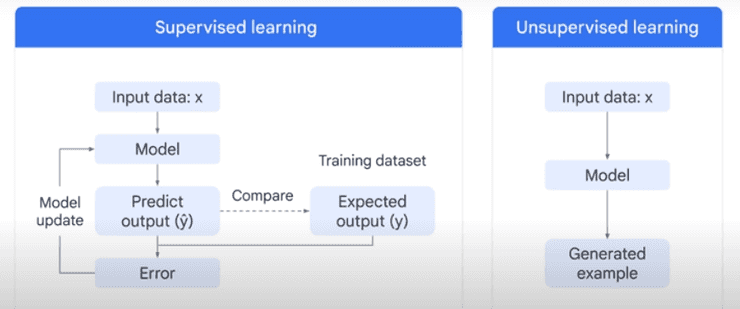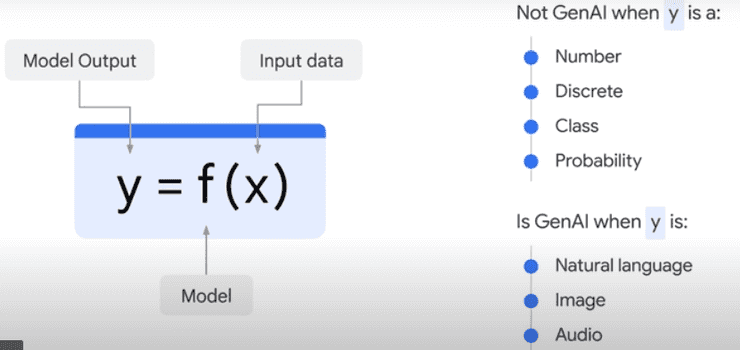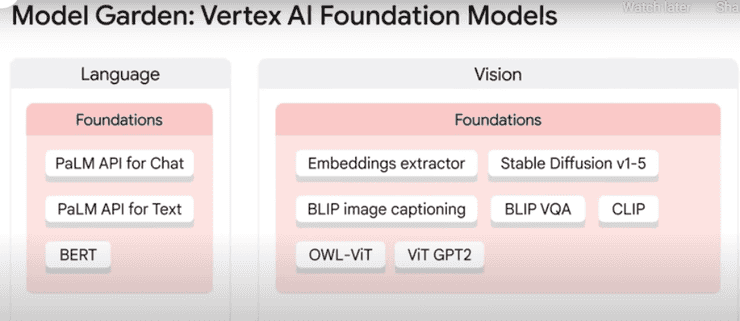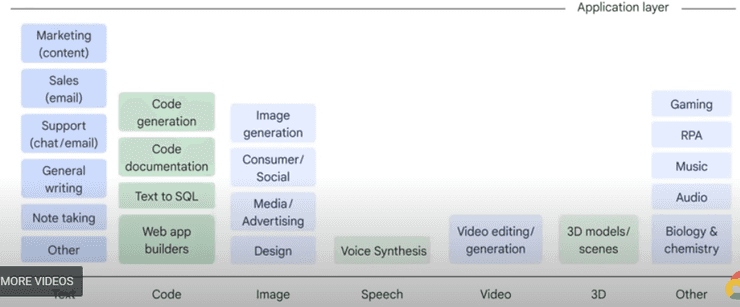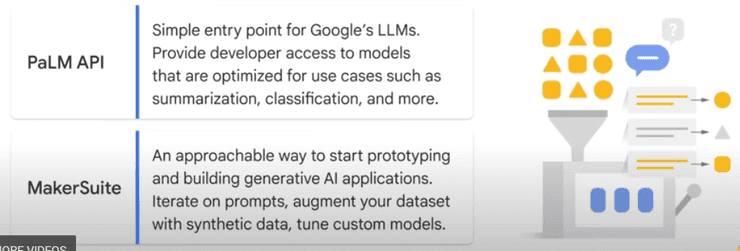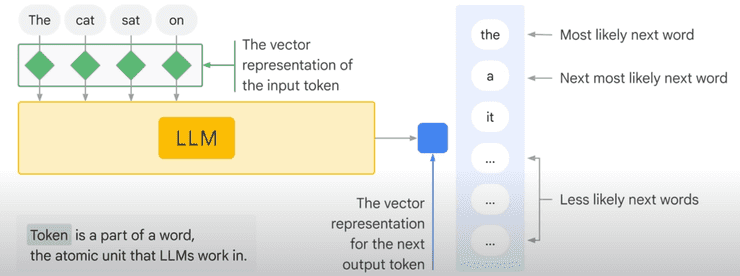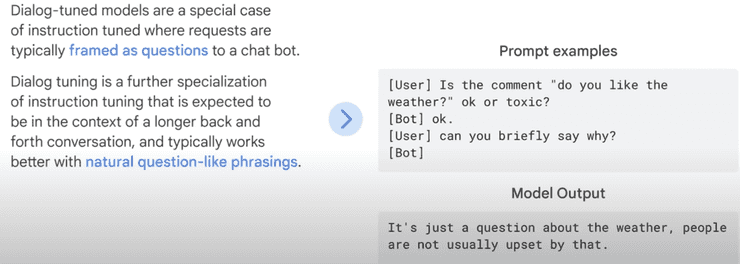Under Construction, Watch Your Step
AI Overview
Big surprise! MLOps is helped tremendously by knowing a fair bit about AI.
- NLP
- CNN vs ANN?
- CV
- Transfer Learning
AI
AI is
-
ML A subset of AI dedicated to taking data from the past and training algorithms to create models that can perform highly complex tasks without being explicitly programmed.
-
Supervised (labeled): learn from past example to make future predictions
- Reinforcement Learning ??? Each iteration, weights are changed to minimize error
- Gradient Decent
-
Deep Learning A subset of ML that uses artificial neural networks to process more complex patterns than traditional ML. Uses ANNs.
- ANN (Artificial Neural Networks)(aka NN)
- Multiple hidden layers (Input Layer - Hidden Layers - Output Layer)
- Can process labeled and unlabeled data.
- “Semi-Supervised Learning”: small amount of labeled data, large amount of unlabeled.
- Labeled helps learn basics of task
- Unlabeled helps the NN generalize to new examples
- Generative AI
- Subset of Deep Learning.
- Uses ANNs so can process labled and unlabeled data.
- Uses Semi, supervised, unsupervised learning.
- Typically involves the Transformer architecture. Essentially, it’s a type of AI that can map long-range dependencies and patterns in large training sets, then use what it learns to produce new content, including text, imagery, audio, and synthetic data.
- Relies on large models, such as large language models (LLMs) that can classify and generate text, answer questions, and summarize documents
- LLM (Large Language Models)
- Subset of Deep Learning
- ANN (Artificial Neural Networks)(aka NN)
-
ML/Deep Learning Model Types
- Model types: Discriminative vs Generative
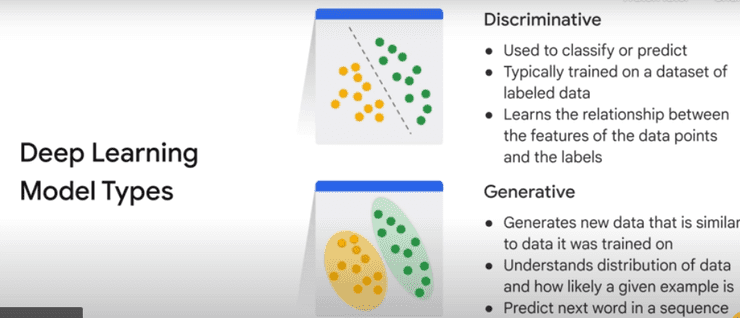
- Discriminative (aka Predictive) used to classify (is this a dog or a cat or something else)
- Generative (aka GenAI) used to generate (create a dog based on all the dog’s you were trained on)
- Classical Supervised and Unsupervised Learning

- New Gen AI Supervised, Semi and Unsupervised Learning
Generate a Foundation Model (aka a statistical model)

- Gen Lang models can be asked questions (prompted)
- PaLM ?
- LaMDA ?
- GPT ?
Transformers
Transformers are “the 2018 revolution” that enabled Generative AI via NLP (Natural Language Processing).
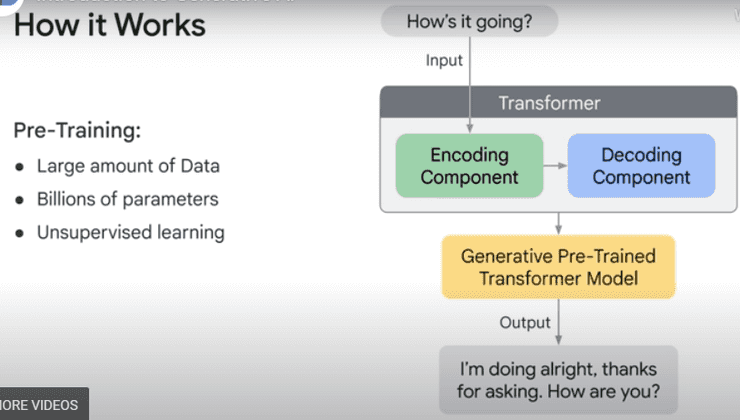
Hallucinations are words or phrases that are generated by the model that are often nonsensical or grammatically incorrect.
Causes of Hallucinations:
- Model not trained on enough data.
- Model trained on noisy or dirty data.
- Model is not given enough context
- Model is not given enough constraints
Prompt Design: the quality of the input determines the quality of the output.
Model Types??
- text-to-text
- NLP lang input to lang output.
- Learn mapping between pairs, e.g. lang translation
- Generation
- Classification
- Summarization
- Translation
- (Re)Search
- Extraction
- Clustering
- Content editing/rewriting
- text-to-image
- text-to-video and text-to-3D
- video gen
- video editing
- Game assets
- text-to-task
- Software agents
- Virtual assistants
- Automation (e.g.: navigate a web GUI)
- Foundation Model
Large Model pre trained on a vast amount of data designed to be adapted or fine-tuned.
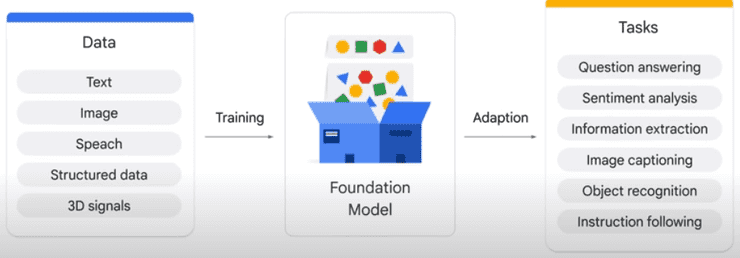
Vertex AI Task Specific Foundation Models
- Sentiment Analysis: use Language > Extraction > Syntax Analysis > Classification > Sentiment Analysis
- Occupancy Analytics: use Vision > Classification > Object Detector > Detection > Occupancy Analytics
GenAI Studio
On Google Cloud. See also SageMaker?
Gen AI App Builder
- No code. Visual WYSIWIG.
- Create your own
- digital asst.
- knowledge base
PaLM API and MakerSuite
Intro to LLMs
- Video by Google, May,2023
- AI > ML > Deep Learning > LLM
- Generative AI
- LLMs: large, gen purpose lang models that are pre-trained and then fine-tuned
- Large
- Petabyte scale dataset
- Large num parameters (called hyperparameters in ML)
- General Purpose
- commonality of human lang
- resource restriction (not many orgs can train an LLM)
- Pre-trained and fine-tuned
- Large
- Benefits of LLMs
- Single LLM can be used for different tasks
- Fine-tune requires minimal field data (aka domain training data)
- Decent performance with “few-shot” (little data) or “zero-shot” (never been trained but works anyway) scenarios
- Performance is continuosly growing with more data and parameters.
Example: PaLM (Pathways Language Model)
- April 2022, Google released it.
- 540 Billion parameters
- Dense decoder only model
- Leverage the new Pathway system (distributed training on multiple TPU (Tensor Processing Units) V4 pods)
LLM Transformers
-
Encoding Component > Decoding Component
-
NN (Neural Networks) circa 2012.
-
Generative: user can train
- Ex:
- LaMDA (Lang Model for Dialogue Apps)
- PaLM
- GPT
- Ex:
LLM Development vs. Traditional Devlopment
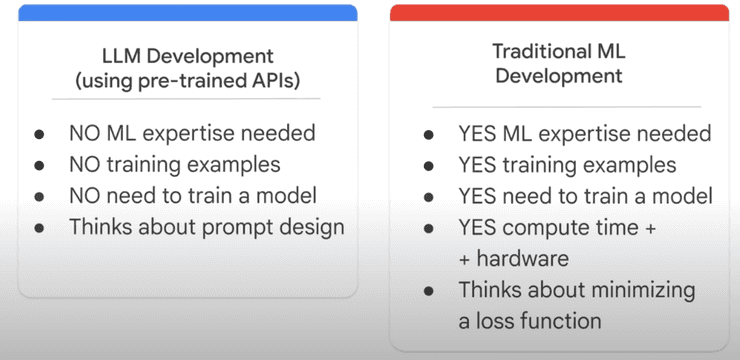
QA (Question Answering)
Traditional QA
- Subfield of NLP that deals with answering questions posed in nat lang
- Retrieves answers from a given text
- Depending on model, answer can be directly extracted from text or generated from scratch
- Requires Domain Knowlege to train
VS Generative QA
- Generates based on context
- Leverages Text Gen models
- No need for domain knowledge
Prompts Design
Prompt Design:
- Process of creating prompts that elicit the desired response from a language model.
- Instructions and context passed to lang model for specific task.
Prompt Engineering:
- Practice of developing and optimizing prompts to efficiently use lang models, for a wide variety.
3 Types of LLM
First 2 are easily confused but very diff.
-
Generic (or Raw): predict next word (aka token)
-
Instruction Tuned: predict a response to the instruction given in the input
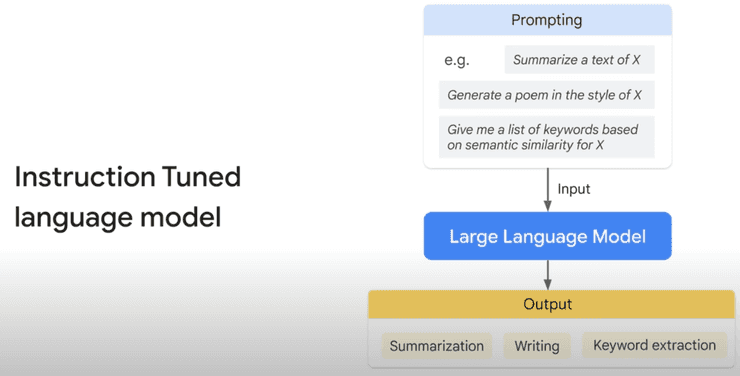
-
Dialog Tuned: have a dialog by predicting the next response.
Chain of Thought Reasoning
Models are better at getting the right answer when they first output text that explains the reason for the answer.
PETM (Parameter-Efficient Tuning Methods)
Fine-tuning an LLM on your own custom data without duplicating the model. The base model itself is not altered. Instead, a small number of add-on layers are tuned, which can be sswapped in and out at inference time.
Prompt Tuning: easiest PETM
VertexAI
Google Clouds Fully Manage ML platform. VS SageMaker, KubeFlow, Azure ML
- Model Garden
- Generative AI Studio
- PaLM 2 for Text and Chat and Embedding API for Text.
- BigQuery ML
- BigQuery
- Vertex Data Labeling
Generative AI on Google Cloud
AI Roles
- Data Scientist
- Data Engineer
- DataOps
- ML Engineer
- MLOps
- Prompt Designer
- Prompt Engineer
?
-
AGI
-
Training
- Gradient Descent
- Sigmoid Functions
- Attention
Types of Models
Open Source
See Hugging Face
- BLOOM by BigScience
- LLaMA by Meta AI
- Flan-T5 by Google
- GPT-J by Eleuther AI
Proprietary
- OpenAI
- co:here
- AI21 Labs
- Antrhopic
To File
- Google Imagen
- Dall-E 2
Misc
Libs and Langs
Libraries
- Pytorch
- TensorFlow
- LLM
LLMs
-
ChatGPT (OpenAI)
-
Google Bard
-
MS Bing AI
Langs
- Python
- R Lang
Autonomous Agents
GPT/LLM backed
- AutoGPT
- GTP-4 undelying
- BabyAGI
- AgentGPT
- Interactive Simulacra (Stanford)
- NPCs controlled by GPT
AutoML Frameworks
- Semantic Kernel
External Tools Access
Thanks to A comprehensive and hands-on guide to autonomous agents with GPT
Autonomous agents can now try to achieve a long-term goal by thinking through the sub-tasks, planning which actions to take, executing the actions with the help of external tools, and reflecting on the results.
- Toolformer
- JARVIS (HuggingGPT)
- VisualChatGPT (TaskMatrix)
- ReAct (Reasoning-Acting)
- Reflexion
Vector DBs
Used by above
- Pinecone
- Weaviate
- Milvus
- Faiss
- Chroma
Websites
OpenAI Hugging Face
ML Ops
Cloud Offerings
Certs
Articles
Building Your Own DevSecOps Knowledge Base with OpenAI, LangChain, and LlamaIndex
